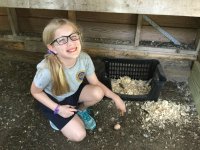Chickens and Checkbooks
A teacher shares what she and her third graders learned from their first experience with project-based learning—a chicken coop.
Your content has been saved!
Go to My Saved Content.“Aha!” moments sneak up on us. For me, it was one July morning after collecting eggs from my flock at home. I was thinking about how relaxing and easy it is to care for chickens—so easy that a child could do it.
I immediately started thinking of all the things I could teach my students about raising chickens: embryology, growth and development of birds, livestock care, composting, selling eggs, multiplication. My list went on and on.
The project fits the project-based learning (PBL) model—which combines real problems with student learning—so I “hatched” the idea of third graders researching and presenting the benefits of chickens on campus.
Finding Partners
I started looking for partners in our community who would be willing to support such an ambitious project. Our headmaster, Hacker Burr, encourages outside-the-box thinking—not only by students, but by faculty as well.
The project was approved immediately, and we started talking about coop placement on campus. Once I received permission from our administration, I started seeking outside funding. I wrote grant proposals to two organizations outlining our project for third-grade students to research and present a proposal to the administration and other community members at our school on the benefits of having chickens on campus.
The ultimate goal was for the students to build their own business. We were fortunate to have two grants awarded to support this endeavor.
Getting Started
When we introduced the idea of the chicken business to the combined third-grade classes, our students were excited and couldn’t believe they had an opportunity to have chickens at school. We posed one key question to students: How can others benefit from having chickens on campus?
Students enjoyed brainstorming the benefits of the coop and how to best care for the chickens. Once a solid list of research topics was compiled, students chose their top three research choices. Finally, they were placed into research groups based on their interests.
Incorporating Interdisciplinary Learning
One of the most exciting things about project-based learning is how it’s a one-stop shop for cross-curricular studies. All students were required to conduct research, contribute a written piece, and participate in a group presentation.
Students applied their science skills to the project by conducting experiments, growing plants, and learning about animal behavior. They conducted an experiment to see if germs, such as E. coli, could be transferred from a fresh egg to a student’s hand. They also tested the relative effectiveness of hand washing and hand sanitizer in killing germs.
They used math skills to determine the required square footage for the coop by first determining what one chicken required and multiplying that by the predicted number of chickens in the flock. They also estimated the number of eggs we would get in one day, week, and month. Students learned financial literacy by researching the cost of supplies for our coop and equipment needed for the flock. They had to determine how to stay within a set budget.
Finally, all students were required to share their work through oral and visual presentations. Students were coached on eye contact, voice projection, and hand gestures to confidently share their knowledge with our invited guests, administrators, and parents.
The Results
The chickens are now thriving in their coop on campus, and this year’s third graders are learning about the growth and development of chickens.
The students this year are also branching out into the world of entrepreneurship. They will develop a business model by identifying the needs of a community and creating a logo, brand, and slogan. They will learn business terms such as problem, solution, cost, unit, profit, revenue, margin, and start-up funds. We will continue to hone skills such as interviewing and internet research to successfully implement their business plan.
In this whole adventure, my passion to connect students to the real world through their learning and my love of animals motivated me. What is your passion? How can you share it with your students so they understand that all these things we do at school have a real purpose and meaning?
Examine the needs of your community and engage your students to research a problem. They will come up with solutions we may not have imagined. Project-based learning encourages students to see a problem with fresh eyes and use their problem-solving skills to create new and innovative solutions to issues.
